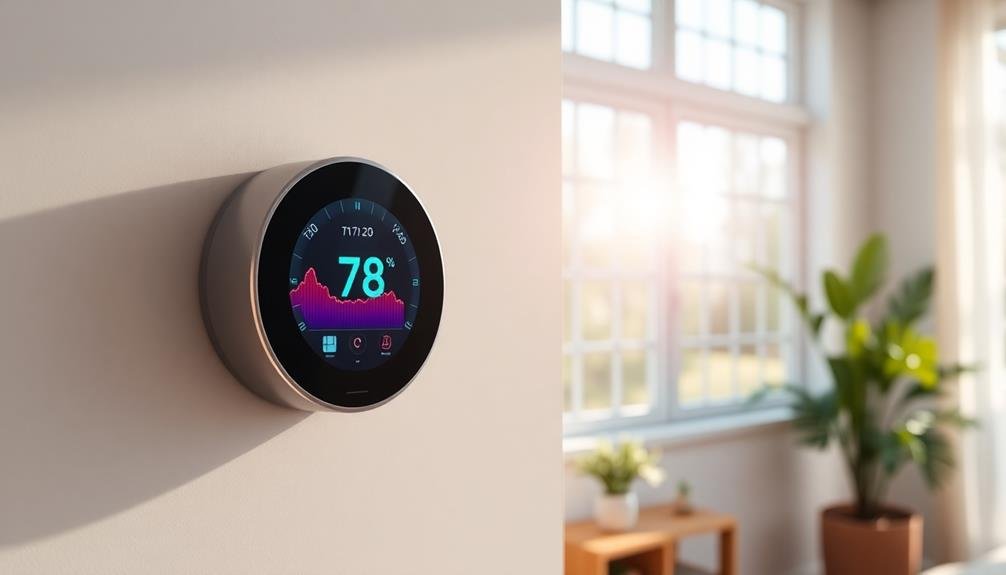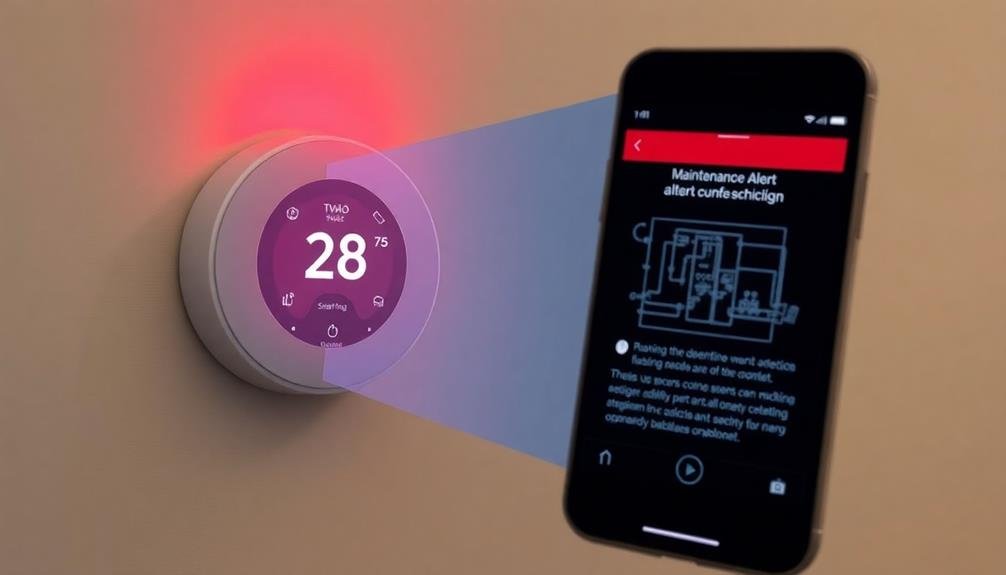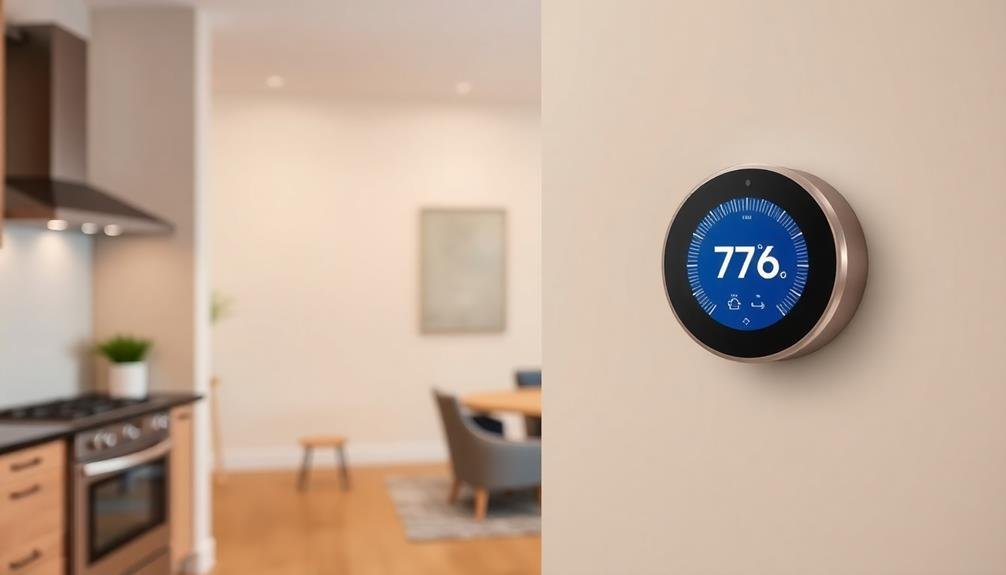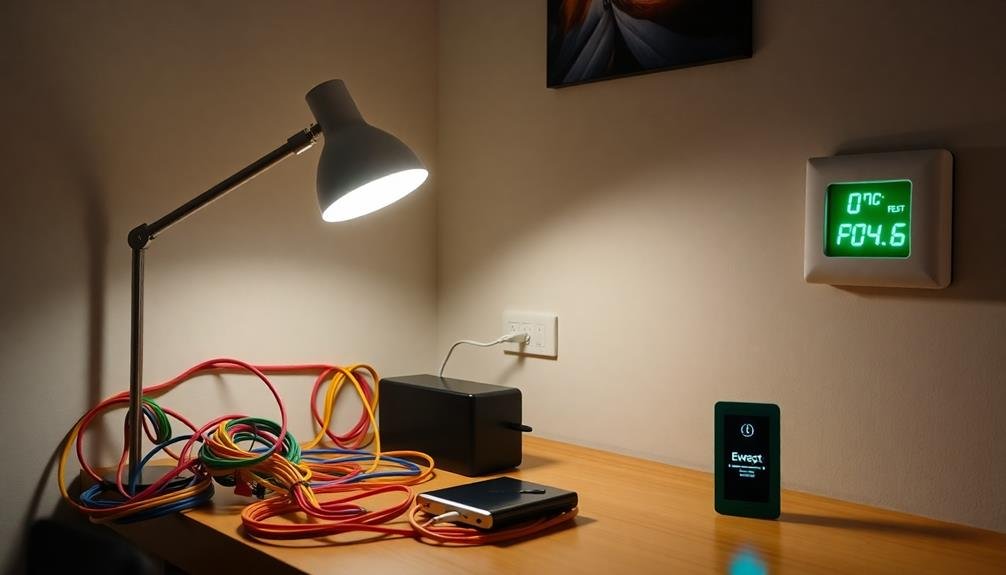AI smart thermostats can revolutionize your home's climate control, saving you energy and money while enhancing comfort. They learn your habits and routines, automatically adjusting temperatures for peak efficiency. You'll enjoy remote control via smartphone, allowing you to pre-heat or cool your home before arrival. These devices integrate seamlessly with other smart home systems, responding to voice commands and creating custom climate zones. They'll monitor air quality, provide energy usage reports, and alert you to maintenance needs. With adaptive scheduling and occupancy detection, your thermostat will always keep you comfortable while minimizing waste. Discover how this technology can transform your daily life.
Energy Savings Through AI Learning

With AI-powered smart thermostats, you're not just controlling your home's temperature; you're optimizing energy consumption. These intelligent devices learn your habits, preferences, and routines to create a personalized heating and cooling schedule.
By analyzing data from sensors and your usage patterns, AI thermostats can predict when you'll be home, asleep, or away, adjusting temperatures accordingly.
You'll benefit from automatic adjustments that reduce energy waste. For instance, the thermostat might lower the temperature when you're at work or sleeping, then warm things up just before you return or wake.
It can also factor in weather forecasts, humidity levels, and even your home's insulation characteristics to make smarter decisions.
Many AI thermostats offer geofencing features, using your smartphone's location to trigger temperature changes as you come and go.
They can also learn how quickly your home heats or cools, optimizing start times for maximum efficiency.
Some models even integrate with smart home systems, allowing for more thorough energy management.
Remote Temperature Control
From the comfort of your office or while lounging on a beach, you can control your home's temperature with AI smart thermostats. These devices offer unprecedented convenience and flexibility, allowing you to adjust your home's climate from anywhere with an internet connection.
Simply use your smartphone, tablet, or computer to access the thermostat's app or web interface.
Remote temperature control isn't just about comfort; it's also about efficiency and savings. You can:
- Lower the temperature when you're away to save energy
- Preheat your home before you arrive on a cold day
- Adjust settings for pets or house plants while you're on vacation
AI smart thermostats often integrate with other smart home devices, creating a seamless ecosystem. You can link them to your security system, voice assistants, or even your car's GPS.
This integration enables automatic adjustments based on your location or daily routines.
Some advanced features include geofencing, which detects when you're approaching home and adjusts the temperature accordingly.
You'll also receive notifications about unusual temperature changes or maintenance needs, ensuring your HVAC system runs smoothly year-round.
Adaptive Scheduling for Comfort

How does an AI smart thermostat anticipate your comfort needs? It uses adaptive scheduling to learn your habits and preferences over time. As you adjust the temperature throughout your day, the thermostat records these changes and begins to recognize patterns.
It'll start to understand when you wake up, leave for work, return home, and go to bed. With this data, your AI thermostat creates a personalized schedule that automatically adjusts the temperature to suit your routine.
You'll wake up to a warm house in winter or a cool one in summer. Before you arrive home from work, it'll start heating or cooling to guarantee peak comfort when you walk in. The system also considers external factors like weather forecasts and humidity levels to fine-tune its adjustments.
What's more, these smart devices can detect when you're home outside your usual schedule. They'll adjust accordingly, guaranteeing you're always comfortable without wasting energy when you're away.
Over time, the AI becomes more accurate in predicting your needs, minimizing the need for manual adjustments and maximizing your comfort and energy efficiency.
Smart Zoning Capabilities
Smart zoning capabilities in AI thermostats allow you to control the temperature in different areas of your home independently.
You'll enjoy targeted temperature control, setting specific comfort levels for each room or zone based on occupancy and preferences.
This advanced feature optimizes energy efficiency by heating or cooling only the spaces you're using, while maintaining personalized comfort settings throughout your home.
Targeted Temperature Control
AI smart thermostats' zoning capabilities revolutionize home climate control by allowing precise temperature management in different areas of your house. You'll no longer have to compromise on comfort or waste energy heating or cooling unused spaces.
These intelligent devices use a network of sensors and smart vents to create customized climate zones throughout your home.
With targeted temperature control, you can:
- Set different temperatures for bedrooms, living areas, and home offices
- Automatically adjust cooling in the kitchen when you're cooking
- Maintain a cooler temperature in your home gym during workouts
You'll enjoy personalized comfort in each room while optimizing energy efficiency. The thermostat learns your preferences and routines, anticipating your needs and adjusting temperatures accordingly.
It'll warm up your bedroom before you wake up and cool down the living room before you return from work. You can easily control these zones through your smartphone or voice commands, making adjustments on the fly.
This targeted approach not only enhances your comfort but also reduces energy waste, potentially leading to significant savings on your utility bills.
Energy Efficiency Optimization
Nearly every homeowner can benefit from the energy efficiency optimization features of AI smart thermostats. These devices use advanced algorithms to analyze your energy usage patterns and environmental factors, creating a customized heating and cooling schedule that maximizes comfort while minimizing energy consumption.
AI smart thermostats can automatically adjust temperature settings based on your daily routines, occupancy patterns, and even local weather forecasts. They'll learn when you're typically home, away, or asleep, and adjust accordingly. You'll save energy without sacrificing comfort.
These devices also offer smart zoning capabilities, allowing you to control different areas of your home independently. You can set different temperatures for various rooms or zones, ensuring you're not wasting energy heating or cooling unoccupied spaces.
Many AI smart thermostats integrate with other smart home devices, such as occupancy sensors and smart windows, to further optimize energy usage. They can also provide detailed energy reports and recommendations for additional savings.
Some models even factor in real-time energy prices to help you take advantage of off-peak rates, potentially reducing your utility bills even further.
Personalized Comfort Settings
Beyond energy efficiency, AI smart thermostats excel at providing personalized comfort through advanced smart zoning capabilities.
These systems use machine learning algorithms to understand your preferences and habits, creating customized temperature profiles for different areas of your home. You'll no longer have to manually adjust settings throughout the day or compromise on comfort for energy savings.
Smart zoning allows you to divide your home into distinct climate zones, each with its own temperature control. This means you can keep your bedroom cool for sleeping while maintaining a warmer living room for evening relaxation.
The AI learns your routines and adjusts temperatures accordingly, ensuring ideal comfort when and where you need it most.
Here's what you can expect from personalized comfort settings:
- Individual room temperature control based on occupancy and preferences
- Automatic adjustments for different times of day and activities
- Integration with wearable devices to fine-tune comfort based on your body temperature and activity level
You'll enjoy a more comfortable living environment tailored to your unique needs, all while maximizing energy efficiency.
The AI continually refines its understanding of your preferences, adapting to seasonal changes and lifestyle shifts to maintain ideal comfort year-round.
Voice Command Integration

Speak, and your AI smart thermostat listens. Voice command integration has revolutionized how you interact with your home's climate control system. With popular voice assistants like Amazon Alexa, Google Assistant, and Apple's Siri, you can now adjust your thermostat settings without lifting a finger.
Simply say, "Set the temperature to 72 degrees," and your AI smart thermostat will comply. You can also ask for current temperature readings, humidity levels, or energy usage stats. Voice commands allow you to create and modify schedules, switch between heating and cooling modes, or activate eco-friendly settings.
This hands-free control is particularly useful when you're busy cooking, working, or relaxing. It's also a game-changer for those with mobility issues or visual impairments. You can even integrate your thermostat with other smart home devices, enabling commands like, "Hey Google, I'm going to bed," to automatically adjust the temperature for sleep.
Many AI smart thermostats offer multi-language support, making them accessible to diverse households. As natural language processing improves, these devices will understand more complex commands and provide even more intuitive interactions, further enhancing your home comfort experience.
Air Quality Monitoring
Your AI smart thermostat can do more than just regulate temperature—it can also monitor your home's air quality.
With built-in sensors, it'll detect pollutants and allergens, providing real-time alerts when air quality dips below ideal levels.
You'll be able to integrate this feature with your ventilation system, automatically adjusting airflow to maintain a healthier indoor environment.
Detect Pollutants and Allergens
Detecting pollutants and allergens has become an essential feature of AI smart thermostats, enhancing their role in maintaining a healthy indoor environment.
These advanced devices use sophisticated sensors to monitor the air quality in your home, identifying harmful particles and potential triggers for allergies or respiratory issues.
AI smart thermostats can detect a wide range of pollutants and allergens, including:
- Volatile organic compounds (VOCs) from cleaning products, paints, and furniture
- Particulate matter like dust, pollen, and pet dander
- Carbon dioxide levels, which can indicate poor ventilation
When these devices detect elevated levels of pollutants or allergens, they'll automatically adjust your HVAC system to improve air circulation and filtration.
They may increase ventilation by running fans or activating air purifiers connected to your smart home network. You'll receive real-time alerts on your smartphone, allowing you to take immediate action if necessary.
Some AI smart thermostats can even learn your daily routines and anticipate potential air quality issues.
For example, they might automatically increase filtration before you return home from work or adjust ventilation during peak pollen seasons.
This proactive approach helps maintain a consistently healthy indoor environment, reducing your exposure to harmful pollutants and allergens.
Real-Time Air Quality Alerts
In recent years, real-time air quality alerts have become a game-changing feature of AI smart thermostats. These advanced systems continuously monitor your indoor air quality, providing you with up-to-the-minute information about potential pollutants and allergens in your home. You'll receive instant notifications on your smartphone or directly on the thermostat's display when air quality levels drop below acceptable standards.
This real-time monitoring allows you to take immediate action to improve your indoor air quality. Whether it's activating your HVAC system's air purification mode, opening windows for ventilation, or addressing the source of pollutants, you'll have the power to create a healthier living environment for you and your family.
| Pollutant | Health Impact | Action Required |
|---|---|---|
| CO2 | Drowsiness | Ventilate |
| VOCs | Headaches | Remove source |
| PM2.5 | Lung damage | Use air purifier |
| Radon | Cancer risk | Seek pro help |
| Mold | Allergies | Dehumidify |
Ventilation System Integration
Smart thermostats with integrated ventilation systems take air quality monitoring to the next level. These advanced devices work seamlessly with your home's HVAC system to maintain ideal indoor air quality. By analyzing real-time data from various sensors, AI-powered thermostats can automatically adjust ventilation rates to address specific air quality issues.
When your smart thermostat detects poor air quality, it'll activate your ventilation system to bring in fresh outdoor air. This process, known as air exchange, helps dilute indoor pollutants and maintain a healthy living environment. The AI algorithms continually learn from your home's air quality patterns, allowing for more precise and efficient ventilation control over time.
Here's how ventilation system integration can benefit you:
- Reduced exposure to indoor air pollutants like VOCs, allergens, and particulate matter
- Improved energy efficiency by fine-tuning ventilation based on occupancy and outdoor conditions
- Enhanced comfort through better humidity control and temperature regulation
You'll enjoy cleaner, fresher air without having to manually adjust your ventilation system. The smart thermostat's ability to integrate with your home's ventilation setup guarantees that you're always breathing the highest quality air possible, contributing to better health and overall well-being.
Weather Forecasting for Efficiency

Weather forecasting capabilities elevate AI smart thermostats to new levels of efficiency. These advanced devices tap into real-time weather data and predictions to enhance your home's temperature control. By anticipating upcoming weather changes, your thermostat can proactively adjust settings, ensuring comfort while minimizing energy consumption.
You'll benefit from the thermostat's ability to factor in expected temperature fluctuations, humidity levels, and even solar radiation. For instance, if a cold front is approaching, the system might pre-heat your home to maintain comfort without overworking when temperatures drop.
Similarly, on a sunny day, it'll consider the natural warming effect of sunlight, reducing unnecessary heating.
This predictive functionality extends to energy-saving opportunities. Your AI thermostat can identify ideal times to run your HVAC system based on forecasted temperatures and energy prices.
It'll cool your home during off-peak hours when electricity is cheaper or when the outdoor temperature is most favorable for efficient operation. By leveraging weather forecasts, your smart thermostat continually fine-tunes its performance, helping you achieve peak comfort and energy savings without constant manual adjustments.
Occupancy Detection and Adjustment
Beyond weather forecasting, AI smart thermostats excel at detecting and responding to your home's occupancy patterns. These devices use a combination of sensors and machine learning algorithms to determine when you're home, away, or asleep. They'll adjust the temperature accordingly, ensuring comfort when you need it and energy savings when you don't.
You'll benefit from occupancy detection in several ways:
- Automatic away mode: The thermostat will lower heating or cooling when it detects you've left, even if you forget to manually set it.
- Room-specific control: Some systems can adjust temperatures in individual rooms based on occupancy, preventing energy waste in unused spaces.
- Learning your routines: Over time, the AI will predict your schedule and adjust temperatures proactively, so you'll always come home to ideal comfort.
These smart devices can also integrate with other home automation systems, like smart locks or security cameras, to enhance occupancy detection accuracy.
You'll save money on energy bills without sacrificing comfort, as the thermostat continuously optimizes your home's climate based on real-time occupancy data.
It's like having a personal climate assistant that knows your preferences and habits, working tirelessly to maintain the perfect balance between comfort and efficiency.
Energy Usage Reports

One of the most valuable features you'll find in AI smart thermostats is their ability to generate detailed energy usage reports. These reports provide you with thorough insights into your home's heating and cooling patterns, allowing you to make informed decisions about your energy consumption.
You'll receive monthly or even weekly breakdowns of your HVAC system's performance, including peak usage times, temperature preferences, and overall energy expenditure. The reports often include comparisons to previous periods, helping you track improvements or identify areas where you can cut back.
AI smart thermostats go beyond simple data presentation. They'll analyze your usage patterns and offer personalized recommendations to optimize your energy efficiency. You might receive suggestions for temperature adjustments, scheduling changes, or maintenance reminders to keep your system running smoothly.
These reports also typically include cost estimates, showing you how much you're spending on heating and cooling. Some advanced models even factor in local energy rates and weather forecasts to provide more accurate projections.
With this information at your fingertips, you'll be empowered to take control of your energy consumption and potentially reduce your utility bills.
Integration With Smart Home Ecosystems
AI smart thermostats shine in their ability to seamlessly integrate with broader smart home ecosystems. They're not just isolated devices; they're part of a larger network of connected appliances and systems in your home. This integration allows for more extensive control and automation of your living environment.
When your AI thermostat is linked to your smart home hub, you can create complex routines that involve multiple devices. For instance, you might set up a "Good Night" routine that not only adjusts the temperature for ideal sleeping conditions but also dims the lights, locks the doors, and arms your security system.
Here's how AI thermostats enhance your smart home experience:
- Voice control: Use Alexa, Google Assistant, or Siri to adjust your home's temperature hands-free.
- Geofencing: Your thermostat can detect when you're leaving or returning home, adjusting settings accordingly.
- Interoperability: It can communicate with other smart devices, like windows or blinds, to enhance energy efficiency.
Maintenance Alerts and Diagnostics

Many AI smart thermostats come equipped with advanced maintenance alert and diagnostic capabilities. These features help you stay on top of your HVAC system's health, potentially saving you money and preventing unexpected breakdowns. You'll receive notifications when it's time to change filters, schedule routine maintenance, or address potential issues before they become major problems.
These smart devices can detect abnormal patterns in your heating and cooling cycles, alerting you to inefficiencies or malfunctions. They'll often provide detailed information about the issue, helping you decide whether it's a simple fix or if you need to call a professional. Some models even offer remote diagnostics, allowing technicians to assess problems without an initial site visit.
Here's a breakdown of common maintenance alerts you might receive:
| Alert Type | Frequency | Typical Action |
|---|---|---|
| Filter Change | Monthly/Quarterly | Replace filter |
| System Check | Bi-annually | Schedule maintenance |
| Abnormal Cycling | As needed | Check for obstructions or call technician |
Frequently Asked Questions
How Long Does It Take for an AI Thermostat to Learn My Preferences?
It typically takes 1-2 weeks for an AI thermostat to learn your preferences. During this time, it'll analyze your adjustments and habits. You'll notice it becoming more accurate in predicting your comfort needs as time goes on.
Are AI Thermostats Compatible With All Types of HVAC Systems?
While many AI thermostats are compatible with various HVAC systems, you'll need to check your specific model. They typically work with central heating, cooling, and heat pumps. However, some older or unique systems may not be fully compatible.
Can AI Thermostats Be Hacked or Pose Security Risks?
Yes, AI thermostats can be vulnerable to hacking. You should be aware of potential security risks, as hackers could potentially access your home network or manipulate temperature settings. It's essential to use strong passwords and keep your device's firmware updated.
Do AI Thermostats Require Professional Installation or Can I Install It Myself?
You can often install AI thermostats yourself if you're comfortable with basic DIY tasks. However, professional installation guarantees proper wiring and setup. Consider your skills and the complexity of your HVAC system before deciding on self-installation or hiring a pro.
How Do AI Thermostats Handle Conflicting Preferences Among Multiple Household Members?
AI thermostats can handle conflicting preferences by learning your household's routines and preferences. They'll create personalized schedules, adjust temperatures based on occupancy, and even allow individual users to set their own preferences through mobile apps.
In Summary
AI smart thermostats can revolutionize your home's climate control. You'll save money and energy while enjoying personalized comfort. With remote access, voice commands, and smart scheduling, you're always in control. These devices learn your habits, detect occupancy, and provide detailed energy reports. They'll integrate seamlessly with your smart home ecosystem and alert you to maintenance needs. Embrace this technology, and you'll wonder how you ever lived without the convenience and efficiency of an AI-powered thermostat.





Leave a Reply